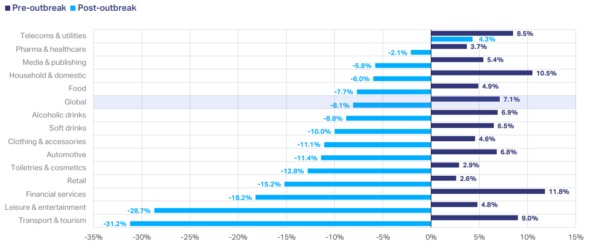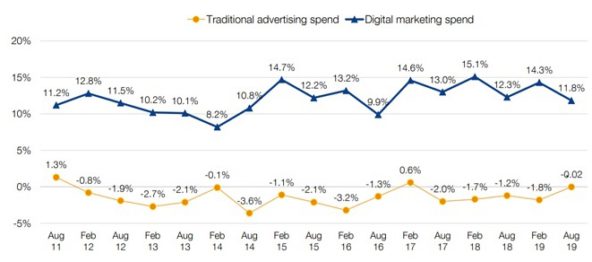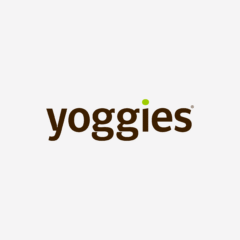From a marketing point of view, a strange kind of summer begins – this time not a season of exotic holidays. Due to the coronavirus pandemic and its consequences, the decline in advertising spend can not be avoided this year, but digital marketing should continue to grow.
A recent study by the World Advertising Research Center (WARC) predicts that advertising spending will fall by 8.1% globally, or USD 49.6 billion, this year as a result of the coronavirus pandemic. If we add to this the originally predicted year-on-year growth of 7.1%, it will even be USD 96.4 billion in lost money. For obvious reasons, the most significant decline is expected in the tourism sector (-31.2%). The study also estimates a significant decrease in ad spend in the entertainment industry (-28.7%), financial services (-18.2%) and retail (-15.2%).

Figure 1: Estimated year-on-year trend (increase / decrease) of advertising spend in individual sectors for 2020. The dark blue colour shows the estimate before the outbreak of the covid-19 pandemic, the light blue colour shows the estimate after its outbreak. The sectors listed above are shown 1) Telecommunications, 2) Pharma and healthcare, 3) Media, 4) Household and domestic, 5) Food, 6) Global, 7) Alcoholic drinks, 8) Soft drinks, 9) Clothing and accessories , 10) Automotive, 11) Toiletries and cosmetics, 12) Retail, 13) Financial services, 14) Leisure and entertainment, 15) Transport and tourism. Source: WARC Data, Nielsen Ad Intel
The cuts should concern mainly advertising through traditional media such as cinema, outdoor advertising, print, radio and television, where the estimated decline in ad spend this year is 16.3% on average, i.e. USD 51.4 billion. dollars. Digital advertising, on the other hand, will continue to grow, albeit by only 0.6% on average, much slower than originally expected.
Digital marketing is relatively immune due to its adaptability to similar fluctuations. It is looking forward to a long-term rise and from year to year it forms a more significant component of the total marketing budget of companies, as evidenced, for example, by CMO Survey. Closely related to this, of course, is the growing number of internet users globally and the average time they spend online. The rapid increase is also evident in the case of the share of mobile devices. Among Seznam users, for example, a full quarter of all users last year were mobile–only users, that is, users who visit our sites and use our services exclusively on their mobile phones.

Figure 2: Comparison of the trend in advertising spend in traditional and digital advertising from August 2011 to August 2019. Traditional advertising (all “non-digital” advertising) is shown as the yellow curve; digital marketing (online advertising) as the blue curve. The percentage values for individual points always express the change, i.e. increase or decrease, from the previous point. Source: cmosurvey.org
The summer will, undoubtedly, be interesting. Not in the traditional spirit of travel, however. But this may help other things stand out all the more. As in previous years, this year will not be a low advertising season. And not at all in “digital”. The shift away from the consumption of media content in the summer months affects digital media less than traditional ones precisely because of people’s increasing affinity for the online environment and the virtual ubiquity of mobile devices. The behavior of users who are used to consuming news and other content on the internet, social networks and the like is relatively stable throughout the year.
To illustrate, when we take data from Netmonitor and compare the number of real users who visited the Seznam homepage during July and November last year, we see two nearly identical numbers (7 vs. 7.1 million RU). To do this, it is necessary to realize that in programmatic and in the online environment in general – unlike in print – there is nothing like a purchased undelivered impression. Each paid impression is issued to a user. If you want someone to see it, it will appear. If not, you do not pay. And you can always accurately measure the impact.
It can be assumed that the budgets set aside for the originally intended spring campaigns will be used to a large extent during the summer, which could hasten the advent of the high season, which would start instead of autumn during July or August and last uninterrupted until Christmas.
Jakub Skřivan





